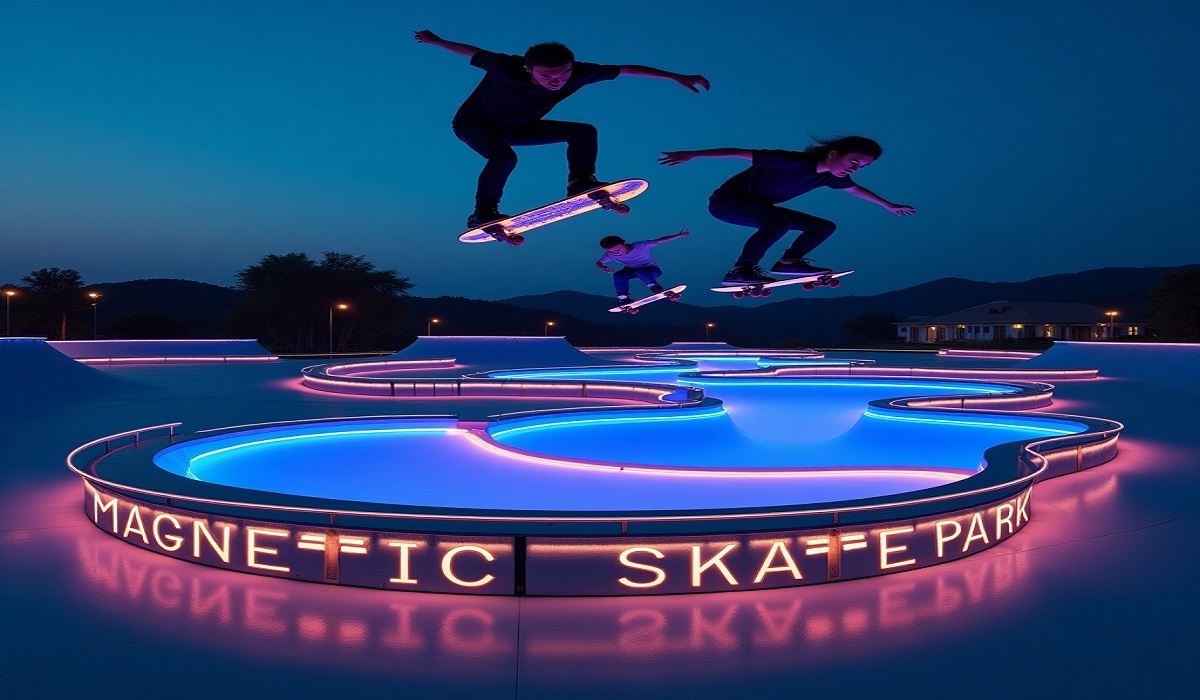Magnetic levitation skatepark designs
Magnetic levitation skatepark designs: Imagine a skatepark where your board glides without touching the ground. There is no rumbling sound of wheels on concrete. The ride is completely smooth and silent. This is the vision behind magnetic levitation skatepark designs.
These are not just ideas from a science fiction movie. Engineers and designers are working on the latest plans to make them a reality. This new approach to building skateparks could change everything we know about action sports.
This article explains the science and the exciting future of magnetic levitation skatepark designs. We will look at how they work, the benefits they offer, and the challenges builders face. Our goal is to provide a clear picture of these innovative spaces. The latest advances in technology are bringing us closer to a new kind of skatepark experience.
How Magnetic Levitation Works in a Skatepark Setting?
The core idea behind magnetic levitation skatepark designs is the same technology used in some advanced trains. It is called maglev, which is short for magnetic levitation. This technology uses powerful magnets to lift an object off the ground. By removing contact with the surface, you also remove friction. Friction is the force that slows down a regular skateboard wheel.
In a practical magnetic levitation skatepark setup, two main components are needed. First, the skateboard must be fitted with special magnets. Second, the ramps, bowls, and half-pipes of the skatepark need a magnetic track or surface.
When these two sets of magnets interact, they create a repelling force. This force pushes the skateboard up, making it hover a small distance above the park’s surface. The latest prototypes show boards hovering just a few centimeters high, creating a truly unique riding sensation.
Making this work requires very precise engineering. The magnets must be strong enough to lift a person and their board. They also need to be arranged in a way that keeps the board stable. You would not want the board to wobble or flip over. The latest magnetic levitation skatepark designs use computer systems to adjust the magnetic field. This ensures a smooth and safe ride, even when performing complex tricks.
Key Benefits of Building a Levitating Skatepark
Why would we want to build a magnetic levitation skatepark? The advantages go beyond just being a cool new idea. These parks offer real benefits for riders, the environment, and the community.
- A Completely New Riding Feel: The most obvious benefit is the ride quality. Without friction from the ground, a levitating board can achieve higher speeds with less effort. The ride becomes incredibly smooth and silent. This allows riders to focus on their balance and the flow of their movement.
- It creates a feeling of flying that is impossible to get with a traditional skateboard.
- Less Wear and Tear: A regular skatepark sees constant wear. Wheels, grip tape, and the concrete itself slowly break down over time. In magnetic levitation skatepark designs, the board does not touch the ground. This means no scratches on the surface and no worn-down wheels on the board. The latest models suggest these parks could last much longer with lower maintenance costs.
- All-Weather and All-Terrain Use: A wet skatepark is dangerous and unusable. Because a maglev board hovers, water on the surface is less of a problem. This opens up the possibility for year-round use, regardless of rain.
- Furthermore, magnetic levitation skatepark designs are not limited to flat surfaces. The latest concepts include complex, multi-level structures that would be difficult to build with concrete.
Current Challenges and Technical Hurdles
While the idea is exciting, creating a real-world magnetic levitation skatepark is not simple. Designers and engineers must solve several difficult problems before these parks become common.
The biggest challenge is power. Creating a magnetic field strong enough to lift a person requires a significant amount of energy. The entire park would need a constant and reliable source of electricity. This makes early magnetic levitation skatepark designs very expensive to operate. The latest research is looking into more efficient magnets and renewable energy sources, like solar panels, to help with this issue.
Safety is another major concern. What happens if the power suddenly goes out? The system needs a fail-safe mechanism. This could be a secondary power supply or a design that allows the board to land gently on a safe surface. Furthermore, the effects of powerful magnetic fields on the human body over long periods are still being studied. Ensuring rider safety is the top priority for all the latest projects in this field.
Finally, there is the challenge of accessibility and cost. The special magnetic skateboard needed for this park would be more complex and expensive than a regular board. This could make it hard for many people to try the technology. The latest magnetic levitation skatepark designs are thinking about rental systems, but making the sport affordable for everyone remains a key goal.
A Look at Real-World Prototypes and Concept Designs
You might wonder if these parks actually exist. While there is not yet a public magnetic levitation skatepark you can visit today, several companies and universities have built working models. These prototypes prove that the technology is possible.
One well-known concept comes from a design collective that created a video of a hovering skateboard. Their model uses a special surface that interacts with magnets on the board. Although it is a small-scale demo, it shows the basic principle in action. It has inspired many of the latest magnetic levitation skatepark designs we see in concept art today.
In a university lab, engineering students built a miniature magnetic levitation skatepark for a science project. Their small ramp used electromagnets to make a tiny skateboard model hover and move along a track. Experiments like these are crucial.
They help experts understand the practical problems and find solutions. Each new prototype brings us one step closer to a full-size park. The latest designs often feature flowing, organic shapes that are easier to achieve with magnetic fields than with poured concrete.
How This Technology Could Change Action Sports?
The arrival of magnetic levitation skatepark designs could start a new chapter for action sports. It would not just be a new type of skatepark; it would be a whole new sport. The skills required to ride a magnetic board are different from traditional skateboarding.
Tricks would be reimagined. Without the grip and pop of a wooden board on concrete, riders would develop a new style. Flowing, aerial maneuvers that use magnetic pulses for lift would become the norm.
Competitions would look completely different, focusing on grace and control in a frictionless environment. The latest concepts even suggest that riders could control their height and speed with body movements, adding a new layer of skill.
This technology could also make action sports more accessible to people who find traditional skating too physically demanding. The smooth, low-impact nature of magnetic levitation could appeal to a wider audience.
It could become a popular recreational activity, similar to ice skating or rollerblading, but with a futuristic twist. The latest magnetic levitation skatepark designs are being created with this inclusive vision in mind.
FAQs About Magnetic Levitation Skatepark Designs
1. How much would it cost to visit a magnetic levitation skatepark?
Early versions of these parks would likely be more expensive than a traditional skatepark due to high energy and maintenance costs. Visitors might pay a session fee, similar to a movie ticket, which could include the rental of a magnetic skateboard.
2. Is it safe to be around such strong magnets?
Safety is the primary focus for all the latest magnetic levitation skatepark designs. The magnetic fields would be carefully contained within the riding area. People with pacemakers or other medical devices would likely be advised to maintain a safe distance, just as they would around other powerful electronic equipment.
3. Could I use my own regular skateboard in this park?
No, you could not. A regular skateboard does not have the necessary magnets. You would need a specially designed magnetic skateboard that is compatible with the park’s system. The park would probably rent these out or have them available for purchase.
4. What stops the board from flying off the track?
The latest magnetic levitation skatepark designs use a combination of magnets. Some provide the lift, while others, called guide magnets, work to keep the board centered on the track. This creates a stable channel that holds the board in place, even during turns and tricks.
5. When can we expect to see one of these parks built?
It is hard to give a exact date. While the technology exists, making a large, public-facing park is a big project that requires a lot of funding and safety testing. Most experts believe we could see a small-scale, pilot magnetic levitation skatepark open within the next decade.
Conclusion
Magnetic levitation skatepark designs represent a bold step into the future of recreational spaces. The latest projects show us a world where skateboarding is smoother, quieter, and more innovative than ever before.
While there are real challenges to overcome, the progress in this field is steady. This is not about replacing traditional skateparks, but about adding a new, exciting option for riders. The dream of gliding on a cushion of air is slowly becoming a reality, promising a new way to play and compete.






